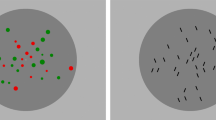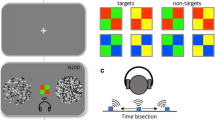Abstract
We investigated the precision of the approximate number system (ANS) in three lemur species (Lemur catta, Eulemur mongoz, and Eulemur macaco flavifrons), one Old World monkey species (Macaca mulatta) and humans (Homo sapiens). In Experiment 1, four individuals of each nonhuman primate species were trained to select the numerically larger of two visual arrays on a touchscreen. We estimated numerical acuity by modeling Weber fractions (w) and found quantitatively equivalent performance among all four nonhuman primate species. In Experiment 2, we tested adult humans in a similar procedure, and they outperformed the four nonhuman species but showed qualitatively similar performance. These results indicate that the ANS is conserved over the primate order.




Similar content being viewed by others
References
Agrillo C, Miletto Petrazzini ME (2012) The importance of replication in comparative psychology: the lesson of elephant quantity judgments. Front Psychol 3:181
Agrillo C, Dadda M, Serena G, Bisazza A (2008) Do fish count? Spontaneous discrimination of quantity in female mosquitofish. Anim Cogn doi. doi:10.1007/s10071-008-0140-9
Agrillo C, Miletto Petrazzini ME, Tagliapietra C, Bisazza A (2012a) Inter-specific differences in numerical abilities among teleost fish. Front Psychol 3:483. doi:10.3389/fpsyg.2012.00483
Agrillo C, Piffer L, Bisazza A, Butterworth B (2012b) Evidence for two numerical systems that are similar in humans and guppies. PLoS ONE 7(2):e31923
Anderson JR, Mitchell RW (1999) Macaques but not lemurs co-orient visually with humans. Folia Primatol 70:17–22
Beran MJ (2008) The evolutionary and developmental foundations of mathematics. PLoS Biol 6:e19
Beran MJ, Johnson-Pynn JS, Ready C (2008) Quantity representation in children and rhesus monkeys: linear versus logarithmic scales. J Exp Child Psychol 100:225–233
Beran MJ, Decker S, Schwartz A, Schultz N (2011a) Monkeys (Macaca mulatta and Cebus apella) and human adults and children (Homo sapiens) compare subsets of moving stimuli based on numerosity. Front Psychol 2:61. doi:10.3389/fpsyg.2011.00061
Beran MJ, Johnson-Pynn JS, Ready C (2011b) Comparing children’s (Homo sapiens) and chimpanzees’ (Pan troglodytes) quantity judgments of sequentially presented sets of items. Curr Zool 57:419–428
Best NG, Cowles MK, Vines K (1995) CODA* convergence diagnosis and output analysis software for Gibbs sampling output Version 0.30. MRC Biostatistics Unit, Cambridge
Blakeslee B, Jacobs GH (1985) Color vision in the ring-tailed lemur (Lemur catta). Brain Behav Evol 26:154–166
Bond AB, Kamil AC, Balda RP (2003) Social complexity and transitive inference in corvids. Anim Behav 65:479–487
Brannon EM (2006) The representation of numerical magnitude. Curr Opin Neurobiol 16:222–229
Brannon EM, Terrace HS (1998) Ordering of the numerosities 1 to 9 by monkeys. Science 282(5389):746–749
Brannon EM, Terrace HS (2000) Representation of the numerosities 1–9 by rhesus macaques (Macaca mulatta). J Exp Psychol Anim Behav Process 26(1):31–49
Cantlon JF, Brannon EM (2006) Shared system for ordering small and large numbers in monkeys and humans. Psychol Sci 17(5):401–406
Cantlon JF, Brannon EM (2007) Basic math in monkeys and college students. PLoS Biol 5(12):e328
Cowles MK, Carlin BP (1996) Markov chain Monte Carlo convergence diagnostics: a comparative review. J Am Stat Assoc 91(434):883–904
Curtis DJ, Zaramody A (1998) Group size, home range use, and seasonal variation in the ecology of Eulemur mongoz. Int J Primatol 19(5):811–835
Deppe AM, Wright PC, Szelistowski WA (2009) Object permanence in lemurs. Anim Cogn 12(2):381–388
DeWind NK, Brannon EM (2012) Malleability of the approximate number system: effects of feedback and training. Front Hum Neurosci 6:68. doi:10.3389/fnhum.2012.00068
Erhart EM, Overdorff DJ (2008) Spatial memory during foraging in prosimian primates: Propithecus edwardsi and Eulemur fulvus rufus. Folia Primatol 79:185–196
Feigenson L (2005) A double dissociation in infants’ representation of object arrays. Cognition 95:B37–B48
Feigenson L, Carey S (2003) Tracking individuals via object-files: evidence from infants’ manual search. Dev Sci 6:568–584
Feigenson L, Carey S, Hauser M (2002) The representations underlying infants’ choice of more: object-files versus analog magnitudes. Psychol Sci 13:150–156
Fichtel C, Kappeler PM (2010) Human universals and primate symplesiomorphies: Establishing the lemur baseline. In: Kappeler PM, Silk J (eds) Mind the gap: tracing the origins of human universals. Springer, Heidelberg
Fisher RA (1930) The genetical theory of natural selection. Oxford University Press, Oxford
Gebuis T, Reynvoet B (2012) The role of visual information in numerosity estimation. PLoS ONE 7(5):e37426. doi:10.1371/journal.pone.0037426
Gelman A, Hill J (2007) Data analysis using regression and multilevel/hierarchical models. Cambridge University Press, Cambridge
Gelman A, Carlin JB, Stern HS, Rubin DB (2004) Bayesian data analysis. Chapman & Hall/CRC, Boca Raton, FL
Genty E, Palmier C, Roeder J (2004) Learning to suppress responses to the larger of two rewards in two species of lemurs, Eulemur fulvus and E. macaco. Anim Behav 67(5):925–932
Gilmore C, Attridge N, Inglis M (2011) Measuring the approximate number system. Q J Exp Psychol 64(11):2099–2109
Gosset D, Roeder J (2000) Colour and shape discrimination in black lemurs (Eulemur macaco). Folia Primatol 71:173–176
Halberda J, Feigenson L (2008) Developmental change in the acuity of the “Number Sense”: the approximate number system in 3-, 4-, 5-, 6-year-olds and adults. Dev Psychol 44(5):1457–1465
Hanus D, Call J (2007) Discrete quantity judgments in the great apes (Pan paniscus, Pan troglodytes, Gorilla gorilla, Pongo pygmaeus): the effect of presenting whole sets versus item-by-item. J Comp Psychol 121(3):241–249
Hauser MD, Carey S, Hauser LB (2000) Spontaneous number representation in semi-free-ranging rhesus monkeys. Proc R Soc 267:829–833
Horvath JE, Weisrock DW, Embry SL, Fiorentino I, Balhoff JP, Kappeler P, Wray GA, Willard HF, Yoder AD (2008) Development and application of a phylogenomic toolkit: resolving the evolutionary history of Madagascar’s lemurs. Genome Res 18:489–499
Houle D (1991) Genetic covariance of fitness correlates: what genetic correlations are made of and why it matters. Evolution 45:630–648
Houle D (1992) Comparing the evolvability and variability of quantitative traits. Genetics 130:195–204
Irie N, Hasegawa T (2012) Summation by Asian elephants (Elephas maximus). Behav Sci 2:50–56. doi:10.3390/bs2020050
Irie-Sugimoto N, Kobayashi T, Sato T, Hasegawa T (2009) Relative quantity judgment by Asian elephants (Elephas maximus). Anim Cogn 12:193–199. doi:10.1007/s10071-008-0185-9
Jacobs GH, Deegan JF (1993) Photopigments underlying color vision in ringtail lemurs (Lemur catta) and brown lemurs (Eulemur fulvus). Am J Primatol 30(3):243–256
Jacobs GH, Deegan JF (2003) Diurnality and cone photopigment polymorphism in strepsirrhines: examination of linkage in Lemur catta. Am J Phys Anthropol 122(1):66–72
Jones SM, Brannon EM (2012) Prosimian primates show ratio dependence in spontaneous quantity discriminations. Front Psychol 3:550. doi:10.3389/fpsyg.2012.00550
Jordan K, Brannon EM (2006a) A common representational system governed by Weber’s law: nonverbal numerical similarity judgments in six-year-old children and rhesus macaques. J Exp Child Psychol 95:215–229
Jordan K, Brannon EM (2006b) Weber’s Law influences numerical representations in rhesus macaques (Macaca mulatta). Anim Cogn 9(3):159–172
Kass R, Raftery A (1995) Bayes factors. J Am Stat Assoc 90:773–795
Leonhardt SD, Tung J, Camden JB, Leal M, Drea CM (2008) Seeing red: behavioral evidence of trichromatic color vision in strepsirrhine primates. Behav Ecol 20(1):1–12
Lewis KP, Jaffe S, Brannon EM (2005) Analog number representations in mongoose lemurs (Eulemur mongoz): evidence from a search task. Anim Cogn 8(4):247–252
Luhrs ML, Dammhahn M, Kappeler PM, Fichtel C (2009) Spatial memory in the grey mouse lemur (Microcebus murinus). Anim Cogn 12:599–609
MacLean E, Merritt D, Brannon EM (2008) Social complexity predicts transitive reasoning in prosimian primates. Anim Behav 76:479–486
MacLean E, Sandel A, Bray J, Oldenkamp R, Reddy R, Hare B (2013) Group size predicts social but not nonsocial cognition in lemurs. PLos One 8(6):e66359. doi:10.1371/journal.pone.0066359
Merritt D, MacLean EL, Jaffe S, Brannon EM (2007) A comparative analysis of serial ordering in ring-tailed lemurs (Lemur catta). J Comp Psychol 121(4):363–371
Merritt D, MacLean E, Crawford JC, Brannon EM (2011) Numerical rule-learning in ring-tailed lemurs (Lemur catta). Front Comp Psychol 2(23):1–9
Mousseau TA, Roff DA (1987) Natural selection and the heritability of fitness components. Heredity 59:181–197
Perdue BM, Talbot CF, Stone A, Beran MJ (2012) Putting the elephant back in the herd: Elephant relative quantity judgments match those of other species. Anim Cogn 15(5):955–961. doi:10.1007/s10071-012-0521-y
Piazza M, Izard V (2009) How humans count: numerosity and the parietal cortex. Neuroscientist 15(3):261–273
Piazza M, Izard V, Pinel P, Le Bihan D, Dehaene S (2004) Tuning curves for approximate numerosity in the human intraparietal sulcus. Neuron 44:547–555
Pica P, Lemer C, Izard V, Dehaene S (2004) Exact and approximate arithmetic in an Amazonian indigene group. Science 306(5695):499–503
Picq JL (1993) Radial maze performance in young and aged grey mouse lemurs (Microcebus murinus). Primates 24:223–226
Picq JL (2007) Aging affects executive functions and memory in mouse lemur primates. Exp Gerontol 42:223–232
Platt ML, Brannon EM, Briese TL, French JA (1996) Differences in feeding ecology predict differences in performance between golden lion tamarins (Leontopithecus rosalia) and Wied’s marmosets (Callithrix Kuhli) on spatial and visual memory tasks. Anim Learn Behav 24:384–393
Roff DA, Mousseau TA (1987) Quantitative genetics and fitness: lessons from Drosophila. Heredity 58:103–118
Rosati AG, Stevens JR, Hare B, Hauser MD (2007) The evolutionary origins of human patience: temporal preferences in chimpanzees, bonobos, and human adults. Curr Biol 17:1663–1668
Ruiz A, Gomez JC, Roeder JJ, Byrne RW (2009) Gaze following and gaze priming in lemurs. Anim Cogn 12:427–434
Rumbaugh DM, Arnold RC (1971) Learning: a comparative study of lemur and cercopithecus. Folia Primatol 14:154–160
Sandel AA, MacLean E, Hare B (2011) Evidence from four lemur species that ringtailed lemur social cognition converges with that of haplorhine primates. Anim Behav 81:925–931
Santos LR, Barnes JL, Mahajan N (2005a) Expectations about numerical events in four lemur species (Eulemur fulvus, Eulemur mongoz, Lemur catta and Varecia rubra). Anim Cogn 8(4):253–262
Santos LR, Mahajan N, Barnes JL (2005b) How prosimian primates represent tools: experiments with two lemur species (Eulemur fulvus and Lemur catta). J Comp Psychol 119(4):394–403
Sauther ML, Sussman RW, Gould L (1999) The socioecology of the ringtailed lemur: thirty-five years of research. Evol Anthro 8(4):120–132
Savage A, Snowdon CT (1989) Apples and oranges: the pitfalls of comparative intelligence. Behav Brain Sci 12(3):605–606
Scarf D, Hayne H, Colombo M (2011) Pigeons on par with primates in numerical competence. Science 334(6063):1664
Shepherd SV, Platt ML (2008) Spontaneous social orienting and gaze following in ringtailed lemurs (Lemur catta). Anim Cogn 11:13–20
Tattersall I (1982) The primates of Madagascar. Columbia University Press, New York
Tomasello M, Hare B, Fogleman T (2001) The ontogeny of gaze following in chimpanzees (Pan troglodytes) and rhesus macaques (Macaca mulatta). Anim Behav 61:335–343
Uller C, Lewis J (2009) Horses (Equus caballus) select the greater of two quantities in small numerical contrasts. Anim Cogn 12(5):733–738
Uller C, Jaeger R, Guidry G, Martin C (2003) Salamanders (Plethodon cinereus) go for more: rudiments of number in an amphibian. Anim Cogn 6:105–112
Veilleux CC, Kirk EC (2009) Visual acuity in the cathemeral strepsirrhine Eulemur macaco flavifrons. Am J Primatol 71(4):343–352
Volampeno MSN, Masters JC, Downs CT (2011) Home range size in the blue-eyed black lemur (Eulemur flavifrons): a comparison between dry and wet seasons. Mamm Biol 76(2):157–164
Wagenmakers EJ, Lodewyckx T, Kuriyal H, Grasman R (2010) Bayesian hypothesis testing for psychologists: a tutorial on the Savage–Dickey method. Cogn Psychol 60:158–189
Wood JN, Hauser MD, Glynn DD, Barner D (2008) Free-ranging rhesus monkeys spontaneously individuate and enumerate small numbers of non-solid portions. Cognition 106:207–221
Wynn K (1992) Addition and subtraction by human infants. Nature 358:749–750
Yoder AD (2007) Lemurs: a quick guide. Curr Biol 17(20):866–868
Acknowledgments
We thank the Duke Lemur Center, Monica Carlson, and the many research assistants who assisted with this research. We thank members of the Brannon laboratory for their helpful discussion of these data. This work was supported by a National Science Foundation CAREER award (No. 0448250) to Elizabeth M. Brannon.
Conflict of interest
The authors declare that they have no conflict of interest.
Ethical standards
The experiments reported here comply with the current laws of the United States of America.
Author information
Authors and Affiliations
Corresponding authors
Electronic supplementary material
Below is the link to the electronic supplementary material.
Rights and permissions
About this article
Cite this article
Jones, S.M., Pearson, J., DeWind, N.K. et al. Lemurs and macaques show similar numerical sensitivity. Anim Cogn 17, 503–515 (2014). https://doi.org/10.1007/s10071-013-0682-3
Received:
Revised:
Accepted:
Published:
Issue Date:
DOI: https://doi.org/10.1007/s10071-013-0682-3




